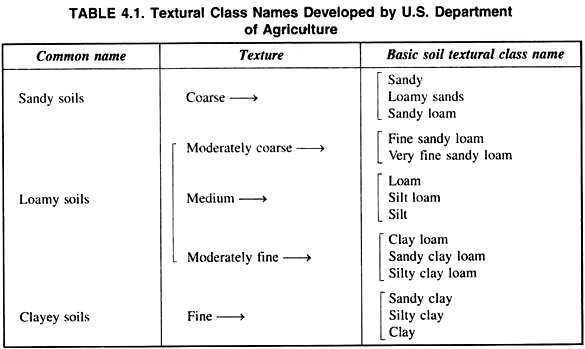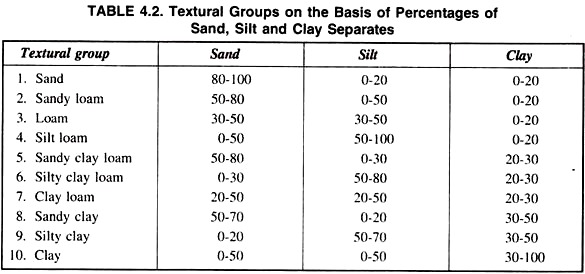ADVERTISEMENTS:
After reading this article you will learn about:- 1. Definition of Soil Texture 2. Classes of Soil Texture 3. Determination.
Definition of Soil Texture:
Soil texture refers to the relative percentage of sand, silt and clay in a soil. Natural soils are comprised of soil particles of varying sizes. Texture is an important soil characteristic because it will partly determine water intake rates (absorption), water storage in the soil, and the ease of tillage operation, aeration status etc. and combinedly influence soil fertility.
As for an example, a coarse sandy soil is easy to cultivate or till, has sufficient aeration for good root growth and is easily wetted, but it also dries rapidly and easily loses plant nutrients through leaching. Whereas in case of high-clay soils (> 35% clay) have very small particles that fit tightly together, leaving very little pore spaces which permits very little room for water to flow into the soil. This condition makes soils difficult to wet, drain and till.
ADVERTISEMENTS:
As the soil is a mixture of various sizes of soil separates, it is therefore, necessary to establish limits of variation for the soil separates with a view to group them into different textural classes. Texture is a basic property of a soil and it cannot be altered or changed.
Classes of Soil Texture:
Texture names are given to soils based upon the relative proportion of each of the three soil separates—sand, silt and clay. Soil that are preponderantly clay, are called clay (textural class), those with high silt content are silt (textural class) those with high sand percentage are sand (textural class). Three broad and fundamental groups of soil texture classes are recognised: sands, loams and clays.
1. Sands:
The sand group includes all soils of which the sand separates make up 70 per cent or more of the material by weight. Two specific classes are recognised—sand and loamy sand.
ADVERTISEMENTS:
2. Loams:
A loamy soil containing many sub-divisions does not exhibit the dominant physical properties of any of these three soils separates sand, silt and clay. An ideal loam soil may be defined as a mixture of sand, silt and clay particles which exhibits light and heavy properties in about equal proportions.
Note that loam does not contain equal percentages of sand, silt and clay. It does, however, exhibit approximately equal properties of sand, silt and clay.
3. Clay:
ADVERTISEMENTS:
A clay soil must carry at least 35 per cent of the clay separate and in most cases not less than 40 per cent. For an example, sandy clay soils contain more sand than clay. Similarly silty clay soils contain more silt than that of the clay. Based on these three broad and fundamental groups, the different textural class names developed by U.S. Department of Agriculture and U.S. Bureau of soils are presented in Table 4.1. and 4.2
Determination of Soil Texture:
1. Feel Method:
ADVERTISEMENTS:
In the field, texture is commonly determined by the sense of feel. The soil is rubbed between thumb and fingers under wet conditions. Sands feel gritty and its particles can be easily seen. The silt when dry feels like flour and talcum powder and is slightly plastic when wet. Clayey particles feel very plastic and exhibit stickiness when wet and are hard under dry conditions.
2. Laboratory Method:
A more accurate and fundamental method has been devised by the U.S. Department of Agriculture for the naming of soils based on a mechanical analysis. From the figure 4.2, mentioned earlier the determination of textural class names can be easily made.
The diagram re-emphasizes that a soil is a mixture of different sizes of particles. This figure also suggests a gradual change of properties with change in particle size since it has not sharp line of demarcation in the distribution of sand, silt and clay fractions.



Comments are closed.